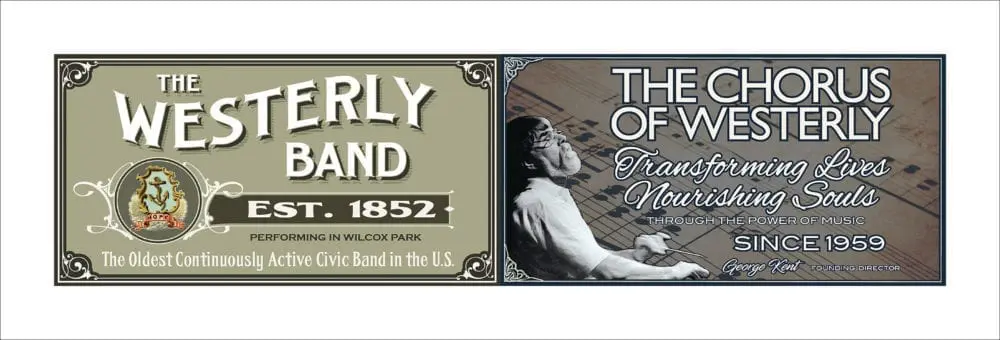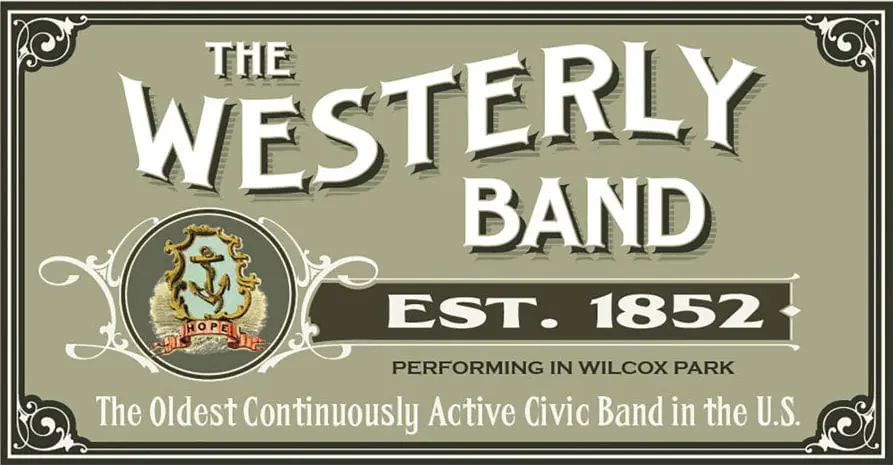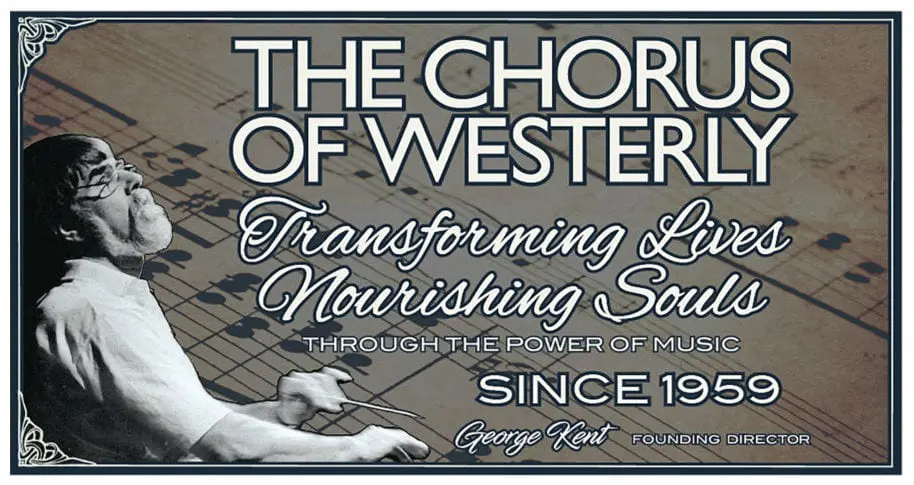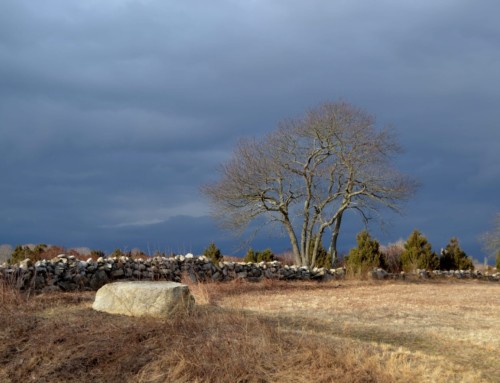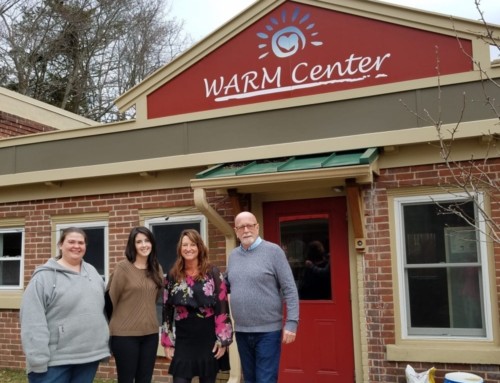The following is part six in Westerly Life’s “Behind the Murals” series discussing the history behind all of the recently created murals throughout downtown Westerly. The murals discussed below are dedicated to the town’s musical history, specifically, two major institutions: the Westerly Town Band and the Chorus of Westerly.
The Westerly Band is the oldest continuously active civic band in the United States.
While details about the band’s formation and its earliest years are scarce, most historian agree that the first iteration of the band was formed in 1852, possibly by a man named Stephen Phalens, although there are also references to a man named W.B. Lowry serving as the band’s first instructor.[1]
Unfortunately, many of this early band’s musicians left Westerly to serve in the Civil War, and the group’s story came to halt. There are very few existing records regarding this band save for an 1854 program for a performance at the Union Meeting House.[2]
In 1863, in an effort to keep spirits high during the war, a new band was formed with eight musicians and was led by A.J. Foster.[3] 1863 is the year cited by the Westerly Band as its formation date, and this still supports their claim to be the country’s oldest continuously active band.
By the following year, the band’s size had more than doubled, and their performances were highly sought after for various functions around town. The group’s membership continued to grow, and by 1875, a separate string ensemble was formed by several of the musicians.[4]
Support for the local band was apparent, especially when the organization was struck by tragedy. In 1891, a fire caused massive damage to the Porter-Loveland Block on High Street, where the band’s second-floor rehearsal rooms were located. The fire destroyed uniforms, instruments, and records (hence, the lack of information regarding the band’s origins). The group needed $1,329.50 to replace the destroyed and damaged items, and this money was easily raised with support from the community.[5]
Competition among local bands was not unheard of, especially during the 19th century. According to a popular story from 1896, the Westerly band and another local outfit, the Sheffield Band, were offered payment to alternate weeks playing in Watch Hill.
These shows were funded by the Norwich-Westerly Electric Railroad in hopes that people in town would take the trolley to Watch Hill to hear the bands play. When a dispute over money developed, the Westerly Band played a free concert in town on the same night that the Sheffield Band was paid to play in Watch Hill.[6]
Another tale of the band’s exploits is from 1933, during the midst of the Great Depression, when a parade was organized in Westerly to give the town an emotional lift. The Westerly Band was featured prominently in the parade, heading and closing several divisions, which they were able to do by bussing musicians from the finish line back to the start several times.[7]
More recently, the band has made efforts to expand its range, with young and old working together. For much of its history, the Westerly Band only accepted men, however, in the 1950’s the first female musician, Paula Richards, was brought in to the group.[8]
More recently, school musicians have also been encouraged to join the band as a way to expand the group’s membership and also to provide young instrumentalists with more experience.[9] The band, a source of local pride, continues on, now in their 154th year of uninterrupted rehearsals and performances.
The Chorus of Westerly mural also serves as a reminder of the town’s musical legacy
The modern Chorus of Westerly, which was founded in 1959 by George Kent, is not, however, the first choral group to call Westerly home. The Westerly Singers, were an all-male group formed in 1941. Much like the Westerly Town Band, this group was forced to halt operations due to the fact that eight members left in early 1942 to serve in World War II.[10]
The group resumed rehearsals in January 1946 when it consisted of twelve men (and advertised openings for “one or two singers” who qualified).[11] The Westerly Singers was made up of men from various walks of life, a fact which was highlighted in the Westerly Sun saying that the group “has in its ranks a carpenter, office executive, printer, gas station owner, mill worker, … a dental surgeon, a forest ranger” and many more.[12]
A month later, in February 1946, another unit, the Westerly Choral Club held its first rehearsal at the Westerly Public Library, with more than 35 people in attendance.[13] The Choral Club struggled, however, as female singers significantly outnumbered male singers, and they were well short of the 60 they needed to achieve their goal.[14] It is not known what became of these groups, however, one can assume that those who were able to join the Chorus of Westerly at its formation in 1959 likely did so.
In the beginning, when the Chorus of Westerly formed in 1959, membership was made up of one-third children aged between eight and 16, and two-thirds adults of all ages, a practice which continues to this day. Initially, adults rehearsed once a week for two hours, while the children rehearsed twice a week for one hour and attended an eight-day music camp each August. This camp was initially held at the YMCA camp, Wind in the Pines, near Worcester, Massachusetts, until moving to Camp Ogontz in Lisbon, New Hampshire in 1965.[15]
In 1960, the chorus included 80 adults and 50 children, and it was during this season that they staged their first musical in front of an audience of 2,500.[16] For over 50 years, George Kent was the driving force between the Chorus’ success, and it was his training with Sir David Willcocks, the director of the King’s College Chapel Choir, which he began in 1968, that led to deep connections to the British Choral scene.[17]
Also in 1968 was the Chorus’ first concert at the former Immaculate Conception Church (built in 1886), which later became the group’s permanent home and is today known as the George Kent Performance Center.[18] In 1972, it was announced that the church was to be torn down, but a one-year lease of the building delayed its demolition until 1973.
During the 1972-1973 season, the Chorus performed its first Celebration of Twelfth Night, which went on to become one of its most popular annual shows. The following year, members of the Chorus organized a group, known as Center for the Arts, with the goal of purchasing the former Immaculate Conception Church. They purchased the church for $40,000 and had it added to the National Register for Historic Places.[19]
By the 1980-1981 season, the Chorus of Westerly embarked on their first tour of Great Britain, which was also attended by the Rhode Island Philharmonic.[20] Just before their departure, the Chorus put on the first Summer Pops concert, which was held in Dixon Square with all traffic stopped. The concert was attended by 5,000 fans.
By 1983-1984, it was clear the now-annual Summer Pops concert had outgrown their set-up in Dixon Square, and the show was moved to Wilcox Park, where it is still held each summer. That year, the concert had more than 15,000 in attendance.[21] In 1990, it was estimated that the concert was attended by more than 30,000 people.[22]
The organization’s expansion continued throughout the 1980’s, and during the 1984-1985 season, they were able to hire a full-time manager and opened a new office in downtown Westerly thanks to a grant from the Rhode Island Foundation.
During the summer of 1987, the Chorus embarked on a highly successful tour of Italy and visited Venice, the Vatican and Milan. In Milan, the chorus performed in in front of more than 13,000 people.[23] By 1991, the Chorus was able to purchase the Center for the Arts building for $165,000, and it was renamed the Chorus of Westerly Performance Hall.[24]
The 1994-1995 season was another special one for the Chorus, as they toured Britain for the second time. During this tour, their performance at St. Alban’s Cathedral was recorded live and later broadcast nationwide in Britain.[25]
During the 2005-2006 season, the Chorus of Westerly Performance Hall was renamed the George Kent Performance Hall as a tribute to the Chorus’ founder and leader for more than 45 years. That same year, Kent was awarded the National Pell Award for Distinguished Achievement in the Arts, making him one of only 32 New Englanders to have won the award.[26]
At the end of the Chorus’ 52nd season in 2011, George Kent announced he would be stepping down as music director from the Chorus at the end of the 2011-2012 season. Kent’s tenure with the Chorus is celebrated vigorously throughout the season, acknowledging his importance to the Chorus’ formation and growth over the course of 53 years. In March 2012, after a nation-wide search, Andrew Howell of the University of Rhode Island was appointed the second music director.[27]
Both the Westerly Town Band and the Chorus of Westerly serve as perfect representations of the town’s musical heritage and the two murals in downtown Westerly are a fantastic reminder of the importance of both groups, which deserve to be remembered for their contributions and celebrated for their continued success.
[su_accordion class=””] [su_spoiler title=”Footnotes” open=”no” style=”default” icon=”plus” anchor=”” class=””]
[1] Chick, Larry, “Westerly and Its Bands” (1982), pg. 1. Courtesy of the Westerly Historical Society.
[2] Chick, pg. 2.
[3] Chick, pg. 2.
[4] Chick, pg. 2.
[5] Chick, pg. 3.
[6] Chick, pg. 1.
[7] Chick, pg. 3.
[8] Westerly Band Webpage, History, http://westerlyband-gov.doodlekit.com/home/history.
[9] Chick, pg. 3.
[10] “Local Singers Will Resume” Westerly Sun, 11 January 1946.
[11] “Local Singers Will Resume” Westerly Sun, 11 January 1946.
[12] “Singers to Give Concert” Westerly Sun, 4 April 1946.
[13] “Choral Club Has Rehearsal” Westerly Sun, 5 February 1946.
[14] “Choral Club Has Rehearsal” Westerly Sun, 5 February 1946.
[15] Chorus of Westerly, “History of the Chorus” https://www.chorusofwesterly.org/history-of-the-chorus.
[16] Chorus of Westerly, “History of the Chorus” https://www.chorusofwesterly.org/history-of-the-chorus, and “Chorus Open to Members” Westerly Sun, 14 September 1960.
[17] Chorus of Westerly, “History of the Chorus” https://www.chorusofwesterly.org/history-of-the-chorus.
[18] Chorus of Westerly, “History of the Chorus” https://www.chorusofwesterly.org/history-of-the-chorus.
[19] Chorus of Westerly, “History of the Chorus” https://www.chorusofwesterly.org/history-of-the-chorus.
[20] Chorus of Westerly, “History of the Chorus” https://www.chorusofwesterly.org/history-of-the-chorus.
[21] Chorus of Westerly, “History of the Chorus” https://www.chorusofwesterly.org/history-of-the-chorus.
[22] Chorus of Westerly, “History of the Chorus” https://www.chorusofwesterly.org/history-of-the-chorus.
[23] Chorus of Westerly, “History of the Chorus” https://www.chorusofwesterly.org/history-of-the-chorus.
[24] Chorus of Westerly, “History of the Chorus” https://www.chorusofwesterly.org/history-of-the-chorus.
[25] Chorus of Westerly, “History of the Chorus” https://www.chorusofwesterly.org/history-of-the-chorus.
[26] Chorus of Westerly, “History of the Chorus” https://www.chorusofwesterly.org/history-of-the-chorus.
[27] Chorus of Westerly, “History of the Chorus” https://www.chorusofwesterly.org/history-of-the-chorus.
[/su_spoiler] [/su_accordion]
